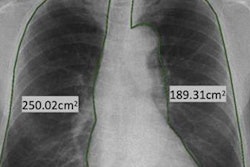
The fact that women tend to have narrower lung airways heightens their risk of chronic obstructive pulmonary disease (COPD) compared with male counterparts, a study published August 2 in Radiology has found.
Having smaller airways can increase vulnerability to lung disease, even among adults who have never smoked or have smoked fewer than 100 cigarettes over the course of their lives, according to a statement released by the RSNA. The study findings complicate what may have been considered a simple picture of who is most at risk for COPD, according to a team led by Dr. Surya Bhatt of the University of Alabama at Birmingham: Although men have higher rates of diagnosis of and mortality from COPD, women are smoking more.
"The prevalence of COPD in women is fast approaching that seen in men, and airway disease may underlie some of the high COPD numbers in women that we are seeing," Bhatt said in an RSNA statement. "When airways narrow due to cigarette smoking, the impact on symptoms and survival is greater in women than in men."
Bhatt and colleagues conducted research that included data from almost 10,000 individuals enrolled the Genetic Epidemiology of COPD (COPDGene) study. COPDGene's participants were current, former, and never smokers between the ages of 45 and 80 recruited from 21 U.S. clinical centers.
All participants underwent chest CT scans. Investigators then quantified airway disease using the following measures (adjusting them for age, height, race, body mass index, smoking pack years, current smoking practice, and lung capacity):
- Airway wall thickness
- Wall area percent
- The square root of the wall thickness of a hypothetical airway with internal perimeter of 10 mm) for airway wall, or Pi10
- Lumen (airway passage in which air flows through) diameter
- Airway volume
- Total airway count
- Airway fractal dimension for airway lumen
The team found that of the 9,363 smokers in the study cohort, men had greater airway wall thickness, while women had narrower segmental lumen diameter -- although in women with either of these airway features, each unit of change translated into poorer lung function, increased shortness of breath, less six-minute walk distance ability, and worse overall survival.
Women's risk for mortality (expressed as hazard ratios, with 1 as reference) related to particular airway measures were higher than men's, especially when it came to airway volume.
| Impact of lung airway measures on mortality by sex* | |||
| Feature | Men | Women | p-value |
| Segmental airway wall thickness (per unit increase, mm) | 2.1 | 3.7 | 0.02 |
| Pi10 (per unit increase, mm) | 0.96 | 1.38 | < 0.001 |
| Airway volume (per unit decrease, dL) | 0.53 | 5.56 | 0.001 |
| Total airway count (per 100 count decrease) | 0.79 | 1.16 | < 0.001 |
"The differences in airway dimensions even after adjusting for height and lung size, and the greater impact of changes in airway size on clinical outcomes in women, was remarkable in that women appear to have a lower reserve against developing airway disease and COPD," Bhatt said.
The study findings underscore the need to factor in sex differences to predict how COPD may further develop, according to the authors.
"Structural differences may underlie some of the differences in predisposition to chronic obstructive pulmonary disease in men and women," they concluded. "These findings have implications for studies targeting disease progression."





















